O
Oak Oak is classified as a dense hardwood, though both desciduous and evergreen varieties exist. Extremely hard and durable, oak has long been used in building ships, buildings and barrels. The coarse grain is considered quite attractive, and absorbs stains and other finishes easily. The wood is resistant to decay, which is a good quality in archival picture framing. |
OBA Optical brightening agents.
A class of chemicals that absorb light energy in one spectrum and emit it in another. When applied to white paper, an OBA can lessen a yellowed appearance. Also called "fluorescent lightening agents", it is applied to some fine art papers to create the bright white often desired. Whether or not OBAs have an archival lifespan is still contested. |
Obeche An African tropical tree, Obeche is a soft hardwood that is commonly used in making guitars, but has become quite popular for picture frame mouldings.
Slightly yellow in color, Obeche has an interlocking, medium-coarse grain and is quite easy to carve and stain. Considering it is generally imported (as plywood or veneer most commonly), it is a relatively inexpensive wood. |
| Off Square The cut of a mat board, artwork or picture frame that results in a parallelogram shape - that is, the vertical and horizontal lines are parallel, but the corners are not square. |
| Offset Applies to displays using multiple mat boards. The offset is the amount of the bottom mat that is showing outside the top mat. 1/4" is the most common offset amount. This means 1/4" of the bottom mat will show on each of the four sides. |
Offset Clips Used to affix a stretched canvas to a frame. Also known as a “Z bracket”, this stepped metal hardware has a hole in either end through which a screw or nail is driven. One end of the bracket is fastened to the stretcher bar frame, the other to the back of the picture frame. Offset clips allow for artwork that is slightly larger or smaller than the depth of the frame rabbet to be fitted. They are also used to attach a canvas to a floater frame.
Order online: Offset Clips |
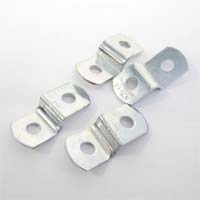 |
| Offset Corners A mat corner style that features a square section of the inner edge left in place, while the rest of the viewing area is cut out. The result is a decorative mat border. |
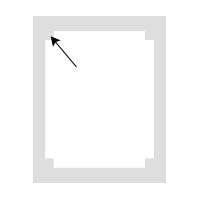 |
| Offset Lithography Also called "offset printing". A printing method that transfers images on metal plates to inked rubber rollers. The rollers then apply the image to the paper as it passes between them. |
| Ogee A common eastern surface moulding and Victorian roof design, the ogee is a decorative shape in art that resembles an onion. It is created by two arches that begin curving in opposite directions at the end, so the peak is made by two close-set, parallel lines. Today, repeated ogee patterns are common on fabric. |
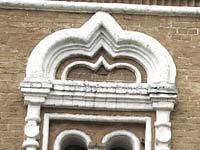 |
| Oil-primed canvas Due to their different properties, canvases used for acrylic and oil painting cannot be primed with the same medium. Canvases prepared for oil painting traditionally use a solvent-based primer, though acrylic primers work for oil painting as well. The primer prevents the paint from soaking into the canvas. |
| Omni Hanger A brand name piece of hardware used to hang metal picture frames. Similar to a euro hanger, one piece is attached to each vertical arm of the frame by sliding it into the back recess and tightening the screw. Wire or string is then threaded between the hangers with some slack, allowing the frame to be hung on the wall. |
| Onyx matboard A brand of mat that produces high-quality, archival matboards for picture framing. |
| Open Edition Print Any series of fine art print for which a limited number of copies was not specified; thousands of copies may be produced. This diminishes the worth of the piece, but also the original cost. |
Optical Brightening Agent (OBA) A class of chemicals that absorb light energy in one spectrum and emit it in another. When applied to white paper, an OBA can lessen a yellowed appearance.
Also called "fluorescent lightening agents", it is applied to some fine art papers to create the bright white often desired. Whether or not OBAs have an archival lifespan is still contested. |
| Ornament Another term for "decoration" or "design". Generally refers to some degree of adornment, as opposed to a flat, blank surface. |
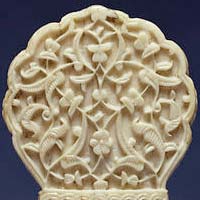 |
| Ornate Ornament Any highly decorative design on a picture frame face. Usually refers to raised adornments (relief). |
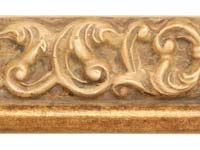 |
| Ornate Style A picture frame style recognizable by its highly decorative face. Ornate picture frames usually feature a raised (relief) design and often are painted in gold or another high-shine finish. |
 |
| Outer mat If a framed artwork has a double mat (a top mat, usually 2" wide, and a bottom mat with a reveal of approximately 1/2"), "outer mat" refers to the top mat, of which a greater amount is seen. |
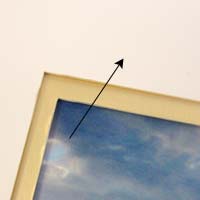 |
| Outgassing The release of gases that occurs in some materials. This process can cause fogging on the inside of an artwork's glass cover if the artwork was not left out to fully dry before being framed. The length of time required differs depending on the machine and the paper used. |
Outside/Outer frame size This measurement refers to the total size of the picture frame, from one outer edge of the frame to the other. In picture framing, this measurement is rarely used, unless the amount of space the frame will take on the wall is an important consideration.
For example: if the frame is bordering an 11x14" print, and the frame width is 2", the outside size of the frame is 15x18" (11"+left frame+right frame; 14"+top frame+bottom frame). |
 |
| Oval frames Any picture frame constructed in a elongated circular shape. An oval frame or image requires height and width measurements much like a rectangular frame, as opposed to the single diameter measurement of a round frame. |
| Oval mats Any mat with an elongated circular opening. The frame holding the mat may be oval as well (requiring the outer mat edge to be oval), or rectangular (requiring the outer mat edge to be rectangular). |
| Overlap Similar to "offset", this refers to the amount of the artwork a picture frame lip or mat will cover on each side of the piece. An overlap is necessary to keep the contents behind from falling through the opening. |
| Oxidation A chemical process that results in an artwork fading over time. Light (both UV and non-UV) makes paint and ink particles more susceptible to an oxidizing agent (air). UV-protective glass or acrylic and acid-free paper can help delay this process for as long as 100 years. |

